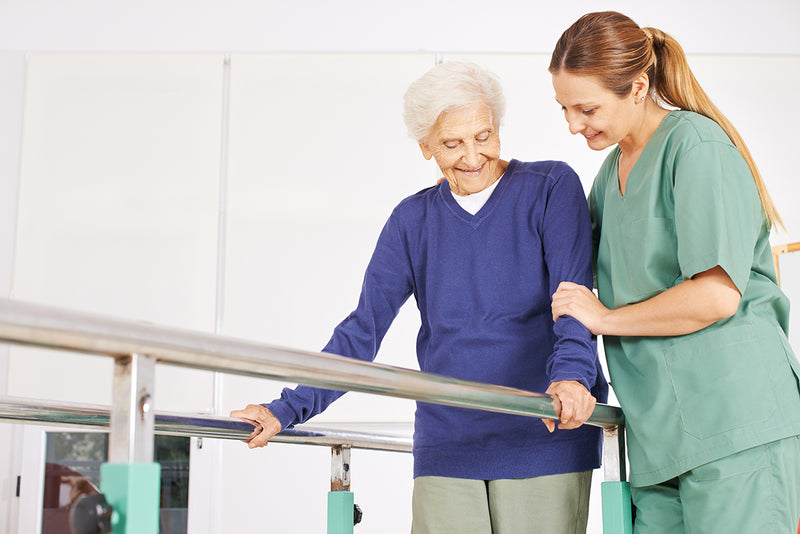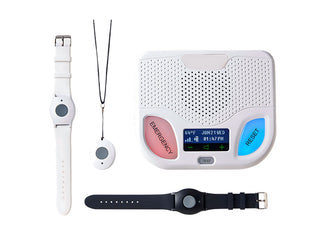Your Safety
Physical Therapy can Help Seniors Prevent Falls

Falls are a serious concern for seniors. According to the CDC, one in four older adults fall each year – and falling once doubles the chance of falling again!
What’s more:
- One in five falls results in a serious injury, like a fracture or head injury.
- Over 800,000 Americans are hospitalized every year following a fall.
- Every day, 88 older adults die as a result of falling.
Seniors who are lucky enough to avoid the hospital still face serious consequences of falling. Many reduce their level of activity, in fear of another fall. However, this quickly leads to weakened muscles, and, in turn, actually increases the risk of falling.
However, as grim as these statistics may sound, it’s important to realize that falling is NOT an inevitable part of growing older. In fact, most falls can be prevented by thinking ahead, staying active, and communicating with your healthcare providers.
Four Steps to Reducing Falls
Experts advise older adults to take four main steps to significantly reduce their risk of falling.
- Stay active, with a focus on exercises that improve strength and balance.
- Improve the safety of the home environment.
- Ask the doctor or pharmacist to review all medications regularly.
- Have vision and feet checked every year.
These steps may sound simple but they’re not necessarily easy.
For example, staying active can be tough for older adults who suffer from chronic pain, balance problems, low energy or a fear of falling. Likewise, improving home safety sounds straightforward enough – until you realize you’re not sure what you’re looking for, or which modifications are really necessary for your situation.
Happily, there’s a valuable resource available that’s very effective in helping older adults reduce their risk of falling – physical therapy.
Using Physical Therapy to Prevent Falls
People are often surprised to hear about physical therapy as a means of fall prevention. Most are more likely to associate physical therapy with thoughts of rehabbing after a major injury or surgery. And with good reason! Physical therapists are the experts when it comes to physical rehabilitation!
However, many people don’t realize that a physical therapist’s expertise doesn’t end with rehab. And that’s a shame because it means they’re missing out on PT’s wide range of benefits – many of which can greatly impact the risk of falling.
For example:
Relieve Pain: PTs use a variety of methods to reduce pain, such as heat and cold, ultrasound, electric muscle stimulation, and massage or stretching techniques. Minimizing chronic pain is an important part of staying active. Pain can also affect mood, mobility, and sleep, all of which can affect activity level and the risk of falling.
Improve Strength and Mobility: Research shows that the single most effective thing older adults can do to reduce their risk of falls is to improve their strength and balance through specialized exercises. There’s no one better than a physical therapist to develop a personalized exercise routine focused on improving strength, balance and mobility, and reducing the risk of falling.
Recommend Assistive Devices: The right cane, walker or wheelchair can improve an older adult's activity level and independence. However, most patients have not been instructed in how to use their device properly or they’re using a device that’s damaged, doesn’t fit them, or isn’t right for their needs. This can do more harm than good! PTs ensure their clients are using the best assistive device for their situation, that it’s in good working order and properly fitted, and that they know how to use it safely.
Improve Confidence: One of the intangible – yet invaluable – benefits of physical therapy is the increased confidence many patients enjoy as they feel themselves growing stronger, steadier, and more knowledgeable about preserving their own independence. Beyond just feeling good, a healthy sense of confidence can go a long way in keeping active and, in turn, reducing falls.
Assess Home Safety: With a doctor’s order, a physical therapist can come into a patient’s home to perform a home safety evaluation. The PT will watch how the individual interacts in their unique environment and recommend specific ways to make the space safer and more supportive of their independence.
Preventing Injuries and Complications from Falls
In addition to preventing falls wherever possible, experts advise taking measures to avoid injuries and complications from potential falls.
To do this, they recommend:
Reduce the chance of broken bones:
- Address and treat any osteoporosis (fragile bones). Doctors often prescribe calcium and vitamin D supplementation to strengthen bones. Talk to your doctor to see if these are right for you.
- Walking and other weight-bearing exercises are best for strengthening bones.
Prevent “Long-lies” (Lying on the floor for a long time after a fall, which can cause severe complications):
- Strengthen lower body muscles, so you’re more able to get up off the ground if needed.
- Learn techniques for how to get up off the ground independently.
- People at high risk for falling should carry a cell phone or wear a medical alert device to summon help immediately if they do fall.
Does Medicare Pay for Physical Therapy for Fall Prevention?
Medicare, Medicare Advantage, and most private insurances will generally cover physical therapy for falls when it’s considered medically necessary. Medical necessity is determined by the doctor or therapist, and it generally is considered necessary if it’s likely to improve function, minimize loss of function or decrease the risk of injury or disease.
Talk to your doctor to determine whether PT would be medically necessary in your case.
Make an Appointment with the Doctor Today
Researchers have found that older adults tend to think that falls are a natural part of aging, while at the same time, they tend to underestimate their own risk of falling.
When they do fall, seniors often plan to simply “be more careful” in the future – however, there’s no evidence to support that being more careful actually reduces the risk of falling!
What has been shown to reduce fall risk more than anything is to minimize risky medication use, correct vision impairments, enhance balance, stay active, and improve home safety.
So, make an appointment with the doctor to discuss your concern about falls, and ask about:
- A medication review
- A vision check
- A foot exam
- A home safety evaluation
- Physical therapy for fall prevention
Make the call sooner than later for the best chance of staying safe, healthy, and on your feet!
Sources
-
Part B Medicare Coverage: Your Guide to Receiving Outpatient Physical Therapy
-
Physical Therapy's Role in Wellness and Injury Prevention - DeePT
-
In-Home Health Physical Therapy for Seniors - Updated for 2021
-
Geriatric Physical Therapy and Types of Exercises for Older Adults
-
The Definitive Medicare Part B FAQ for Outpatient PT, OT, and SLP
-
Exercise for Your Bone Health | NIH Osteoporosis and Related Bone Diseases National Resource Center







